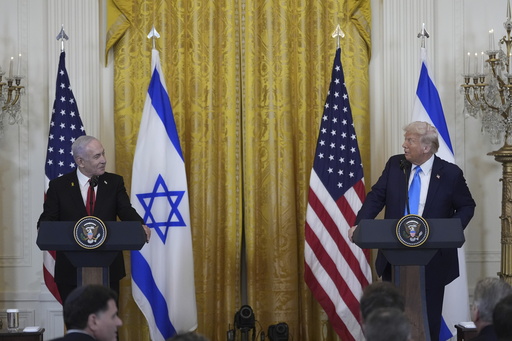
JERUSALEM — In a dramatic move last week, Hamas hinted at canceling the release of three Israeli hostages, prompting an unexpected ultimatum from U.S. President Donald Trump. Speaking from the Oval Office, Trump urged Hamas to free all of the over 70 hostages by noon Saturday, warning that “all hell is going to break loose” should they fail to comply. He reiterated his stance, stating, “They’ll find out what I mean. Saturday at 12.” Israeli Prime Minister Benjamin Netanyahu echoed Trump’s sentiments, suggesting that the entire hostage arrangement could fall apart. Ultimately, Hamas released the three hostages as planned, and in exchange, Netanyahu freed numerous Palestinian prisoners; however, Trump’s deadline came and went without any additional releases.
This incident highlights the unpredictable nature of Trump’s approach to Middle Eastern diplomacy, characterized by bold proclamations and erratic outcomes. While some of his tactics have led to significant achievements, such as the 2020 Abraham Accords—which normalized relations between Israel and four Arab nations—there’s also a growing worry that this style could further destabilize an already volatile area, showing little progress in resolving the long-standing conflict between Israelis and Palestinians.
One of Trump’s most audacious and controversial initiatives has been his proposal to relocate the entire population of Gaza, which numbers around 2 million, out of the territory. He envisions the U.S. assuming “ownership” of Gaza, overseeing a multi-year reconstruction effort, and stipulates that Palestinians should not return—a troubling prospect for a people who have faced mass displacement since Israel’s founding 76 years ago. This strategy has faced outright rejection from Palestinian leaders, and there remain significant unanswered questions about the logistics of such a plan, including where the displaced would go, who would accept them, and how the operation would be funded. Legal experts and human rights advocates have deemed this initiative a potential war crime.
Whether Trump’s plan is a genuine proposition or merely a tactic to push regional players back towards negotiations is uncertain. Nonetheless, Netanyahu has expressed support for the idea, declaring it “right on the dot.” Polls show that Israeli public opinion strongly favors Trump over Democratic nominee Kamala Harris, suggesting a robust partnership between the two leaders. Last month, Netanyahu was the first foreign leader to meet with Trump in the White House post-inauguration, receiving a warm welcome as Trump revealed his Gaza proposal.
Interestingly, Netanyahu has embraced what was once a radical notion among the ultranationalist factions in Israeli politics. Following Trump’s lead, Netanyahu has maintained close communication with U.S. officials during the hostage crisis, referring to Trump as “the greatest friend that Israel has ever had” and emphasizing their joint efforts against Iran, among other issues.
However, the response from Arab nations has been mixed and largely negative. Key regional allies are pushing back against Trump’s plans, which they see as detrimental to their own stability and an existential threat to the Palestinian struggle. For instance, during his visit to the White House last week, King Abdullah II of Jordan expressed reluctance towards the plan. Egypt has likewise dismissed the proposal regarding displaced Palestinians. A pivotal moment is expected during U.S. Secretary of State Marco Rubio’s forthcoming visit to Saudi Arabia, as Trump and Netanyahu hope to establish full diplomatic ties between Israel and the Saudis. Nevertheless, the Saudis demand a clear roadmap toward Palestinian sovereignty before considering normalization with Israel.
The aftermath of the ongoing conflict has also intensified fears across the Middle East. Embracing a policy that forcibly displaces millions of Palestinians could stir unrest within countries that have large segments of the population supporting the Palestinian cause, including Egypt, Jordan, and Saudi Arabia. Egypt has conveyed that such actions might threaten its decades-old peace agreement with Israel, which has been crucial for maintaining regional stability.
Despite the contention, there seems to be a newfound urgency in the region, as Egyptian officials are reportedly crafting their own post-conflict strategy for Gaza and are set to convene an Arab summit soon. Rubio has asserted that if nations oppose American proposals, they should present alternatives. “We cannot sustain the same cycle that leads us back to square one,” he noted. From the Arab perspective, lingering issues stem from the United States’ unwavering support for Israel amid its occupation of Palestinian territories, a situation potentially exacerbated under Trump’s administration.
As Trump’s administration navigates these complex dynamics, there is uncertainty ahead. His Middle East team, spearheaded by envoy Steve Witkoff, has played a pivotal role in brokering a six-week ceasefire, even before Trump officially took office. However, the current ceasefire is nearing its expiration, and Netanyahu has conveyed mixed signals regarding future steps. While he has hinted at a resumption of hostilities to appease far-right elements within his coalition, he has also committed to pursuing further negotiations aimed at a peaceful resolution of the conflict. The future path remains uncertain, presenting challenges for both Netanyahu and his unpredictable ally in Washington.

